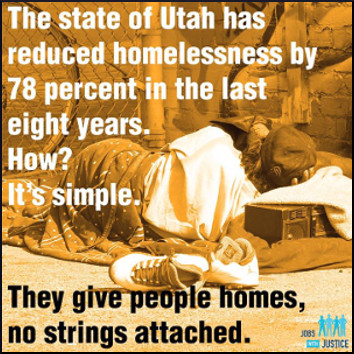
On Sunday, November 15, the Homeless Sunrise Memorial Service took place in Austin, TX. It was the 23rd annual service, and 171 names were read, names of people who died in poverty in the city from October 2014 to the same month of this year. Anyone can learn more about it from the House the Homeless homepage, but the most important reason to go to that page now is to find out how to donate to the Thermal Underwear Drive, a major initiative that also takes place every year in Austin.
The annual memorial is perfectly fitting, and so is the annual National Hunger and Homelessness Awareness Week (this year, it was November 15-21). The downside of annual events, however, is that the space between them lets matters slip from the forefront of our consciousness the rest of the time.
At some point, the realization has to strike: every day, people die in poverty. Every day, people are hungry. Every day, people shiver with cold or gasp from heat stroke. Every day, people know the embarrassment of not having a safe place to take a dump, or having anything to wipe with. Every day, people suffer the humiliation of letting themselves be treated like human garbage, because they know that the smallest increment of assertiveness could have unthinkably terrible consequences.
Baby, It’s a Wild World
Although most people experiencing homelessness are peaceful, their rejection of violence makes their lives on the streets even more dangerous. People who want nothing more than to be left alone are hurt every day by the relatively small number of predators who are also homeless. Or they are hurt by housed people who see them as the enemy. Or they run afoul of the law, with varying degrees of trauma.
Austin American-Statesman writer James Barragan tells the story of a man whose transition into homelessness and eventual premature and needless death began with the death of his mother. Before following the rest of his tragic steps, one is tempted to ask (as someone from another country or another planet might), “Why wasn’t grief counseling available to him? Or if it was, what prevented him from taking the opportunity?” Could our society do a better job of helping people cope with the horrors of life, so the first step on a self-destructive path will not be taken?
In this particular case, the man who wound up homeless and dead had been troubled all his life by the knowledge that he was adopted. Sometimes, even the most loving adoptive parents can’t fill the void that results from a child’s awareness of having been abandoned. So many stressors break up families or prevent them from ever forming in the first place. Could our society do more to alleviate those pressures? The reporter spoke with relatives and friends of other homeless people who had died. A criminal record is a real handicap, and a very easy thing to acquire. Could our society thrive with fewer laws and fewer of its citizens behind bars? It quite probably could.
House the Homeless, since its inception in 1989, has always felt that Housing First is the best approach…hence the organization’s name. Through Housing First, people are able to stop street abuse that includes violence, rape, and quality-of-life ordinances that criminalize homelessness and act as barriers to escaping homelessness.
Barragan talks about the Housing First concept:
Once housed, the theory goes, the groups can help people tackle their other problems. But often, the general public thinks homelessness is an unsolvable problem and that those experiencing it have done it to themselves by not working hard enough or drinking or drugging themselves into ruin.
A brand-new report from the Associated Press does little to change such perceptions, saying:
An examination of deaths among the homeless in the Austin region show they’re dying of homicide, suicide and accidents at a rate much higher than the general population…While 86 percent of Travis County residents die of natural causes, only 29 percent of the homeless included in the analysis did, according to the report.
In 49% of the fatalities, alcohol “played a role” and in 36%, drugs “were a factor”—but some of these were the same people. In other words, in many cases alcohol and other drugs were both contributing factors. But in others, substances played no role.
The AP interviewed House the Homeless founder Richard R. Troxell, who was particularly articulate about the 11% of homeless deaths that occurred within a few days of the deceased being discharged from a jail or hospital. For more about that, see our archived post, “No ‘Discharge to Nowhere’.”
We also recommend James Barragan’s “Shining a light on a vulnerable population,” and the Austin American-Statesman‘s splendidly interactive map.
And please, don’t forget the Thermal Underwear Drive!
Reactions?
Source: “A humanizing look behind the numbers of homeless deaths in Austin.” MyStatesman.com, 11/15/15
Source: “Report: Homicide, violence claim high number of homeless.” Star-Telegram.com, 11/15/15
Image by Jobs with Justice


